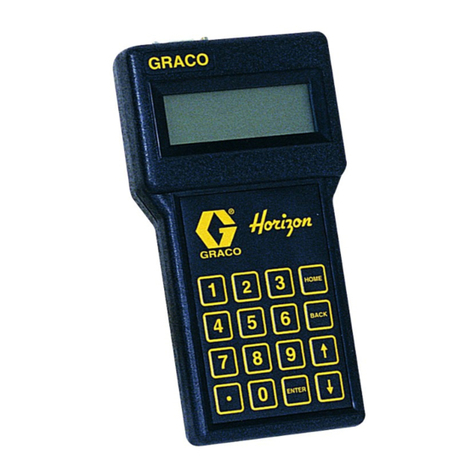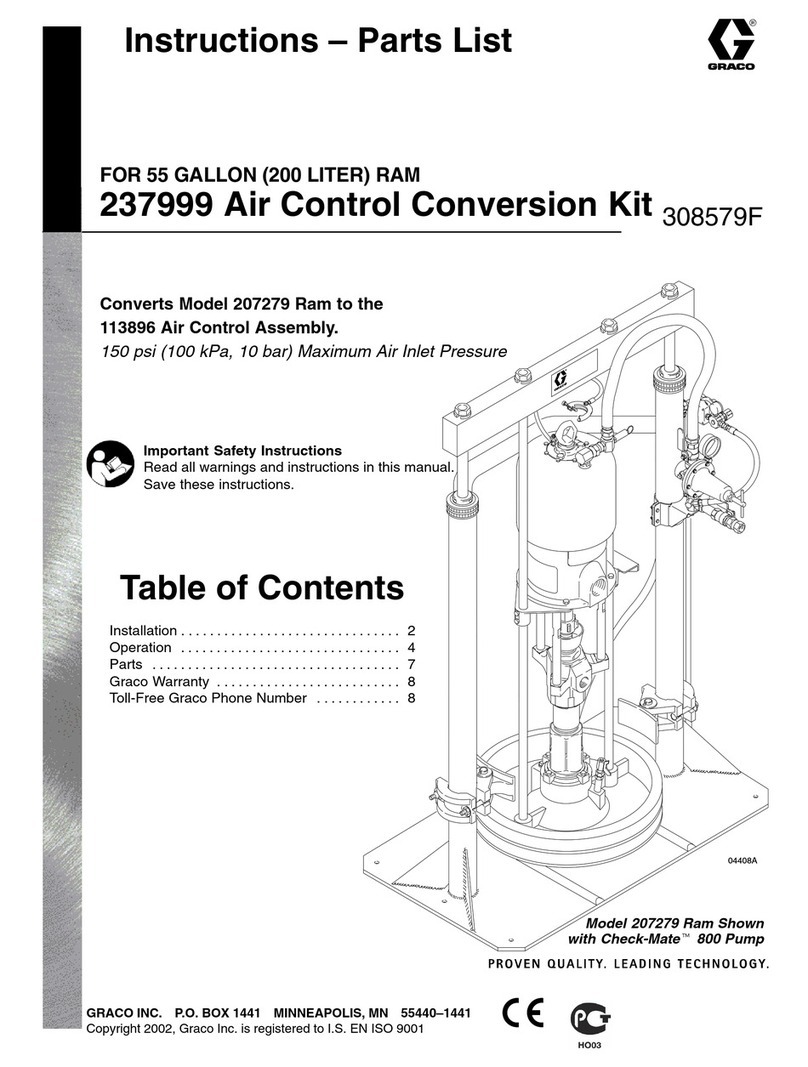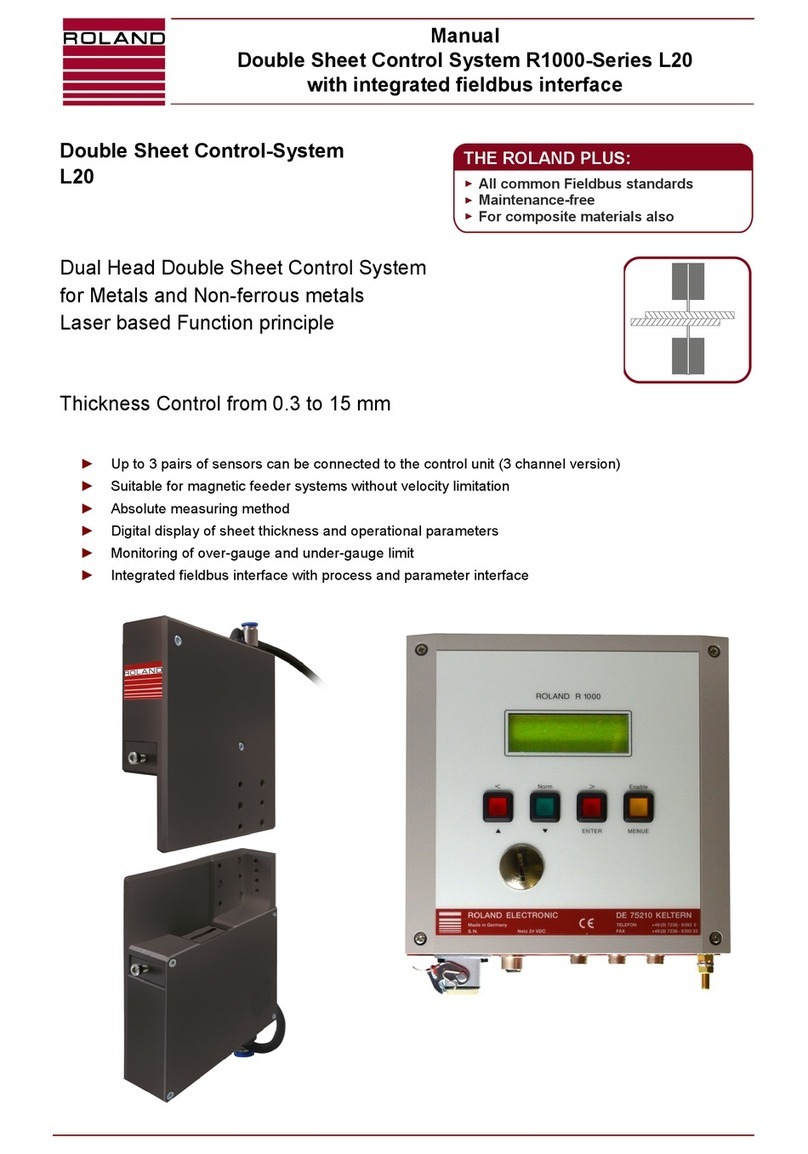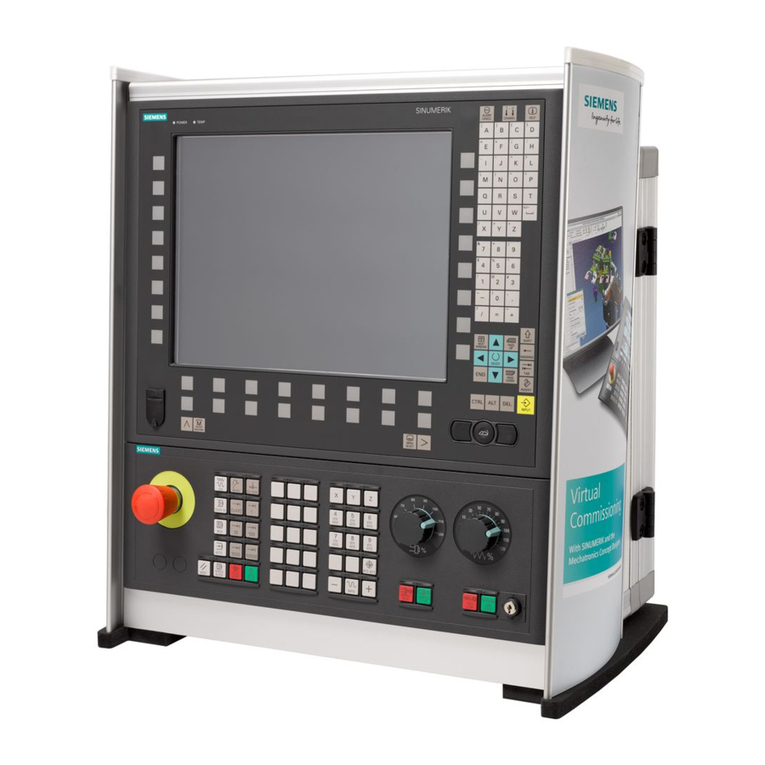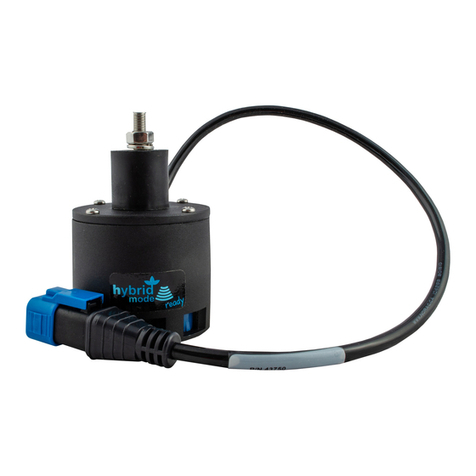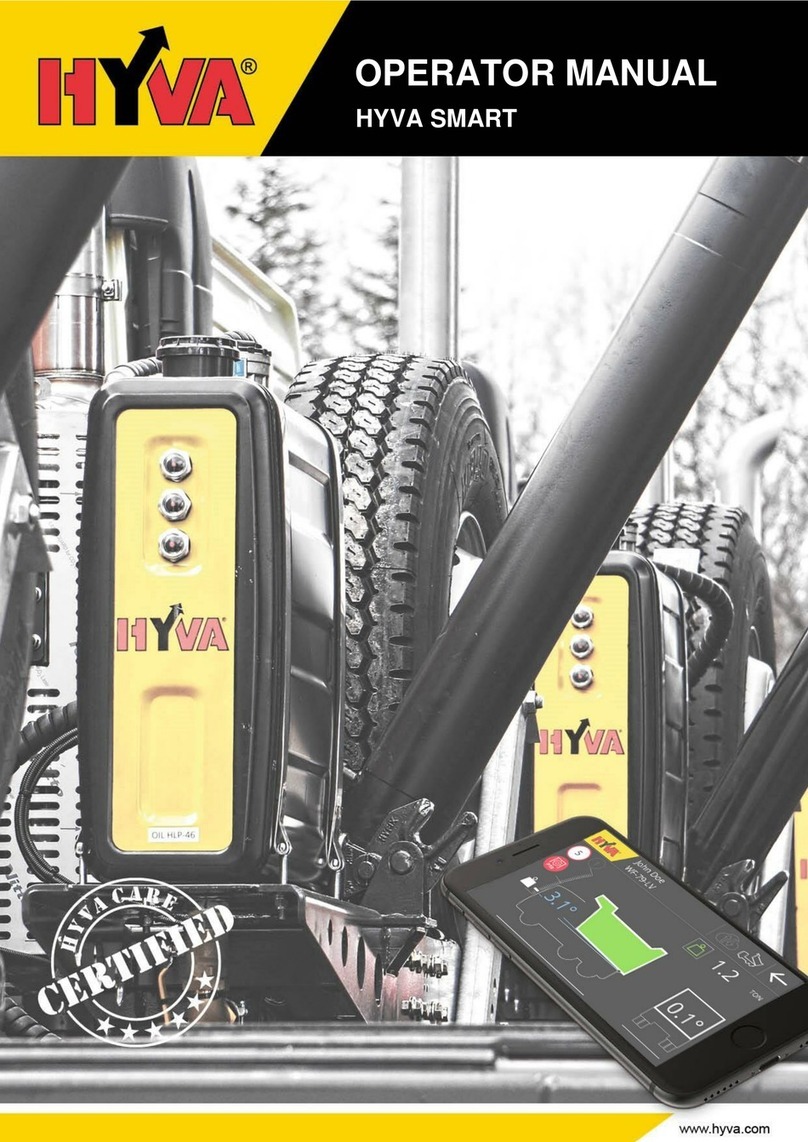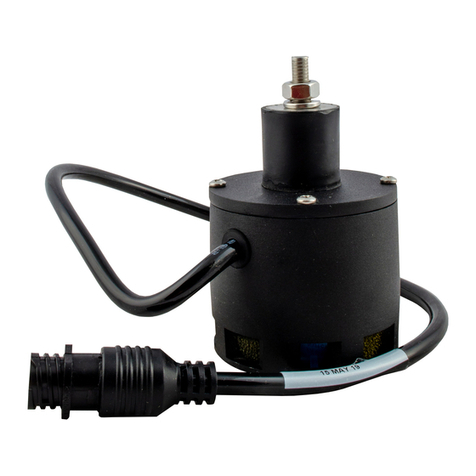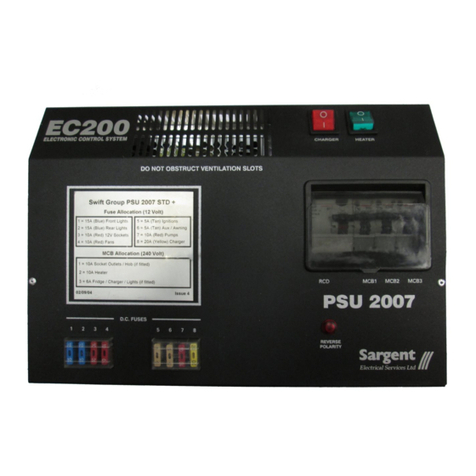Graco PrecisionFlo 918463 Operation manual

310531
Rev. C
Supersedes B
First choice when
quality counts.
t
INSTRUCTIONS-PARTS LIST
INSTRUCTIONS
This manual contains important
warnings and information.
READ AND KEEP FOR REFERENCE.
PrecisionFloControl Assembly
For use when dispensing fluids that meet at least one
of the following conditions for non-flammability:
DThe fluid has a flash point above 140_F (60_C) and
a maximum organic solvent concentration of 20%,
by weight, per ASTM Standard D93.
DThe fluid does not sustain burning when tested per
ASTM Standard D4206 Sustained Burn Test.
Part No. 918463
Control Assembly with Pendant
Part No. 918644
Control Assembly with Keypad
8646A
GRACO INC. P.O. BOX 1441 MINNEAPOLIS, MN 55440–1441
http://www.graco.com
ECOPYRIGHT 1996, GRACO INC.
Graco Inc. is registered to I.S. EN ISO 9001

2 310531
Table of Contents
Warnings 3. . . . . . . . . . . . . . . . . . . . . . . . . . . . . . . . . . . . .
PrecisionFlo Module Overview 6. . . . . . . . . . . . . . . . .
What This Manual Includes 6. . . . . . . . . . . . . . . . . .
PrecisionFlo Module Description 6. . . . . . . . . . . . . .
PrecisionFlo Module Capabilities 7. . . . . . . . . . . . . .
Typical Fluid Applications 7. . . . . . . . . . . . . . . . . . . .
PrecisionFlo Features 7. . . . . . . . . . . . . . . . . . . . . . .
PrecisionFlo Options 8. . . . . . . . . . . . . . . . . . . . . . . .
Instruction Manual Conventions 8. . . . . . . . . . . . . . .
PrecisionFlo Definitions 8. . . . . . . . . . . . . . . . . . . . . .
Installation 10. . . . . . . . . . . . . . . . . . . . . . . . . . . . . . . . . .
Installing Control Assembly Hardware 11. . . . . . . . .
Installing the Control Assembly Enclosure 11. . . . .
Grounding Control Assembly 918463 13. . . . . . . . .
Grounding Control Assembly 918644 14. . . . . . . . .
Verifying Ground Continuity 15. . . . . . . . . . . . . . . . .
Connect PrecisionFlo Control Assembly
to Power Source 15. . . . . . . . . . . . . . . . . . . . . . . . . . .
Checking Resistance Between the
Control Assembly and the
True Earth Ground 15. . . . . . . . . . . . . . . . . . . . . . . . .
Connecting Fluid Lines, Air Lines, and Cables 16.
Loading Material into PrecisionFlo Module 18. . . . .
Material Loading Procedure 18. . . . . . . . . . . . . . . . .
Configuring Pressure Sensors 19. . . . . . . . . . . . . . .
Entering Nominal Values for Kp and Kd 21. . . . . . .
Calibrating PrecisionFlo Module 21. . . . . . . . . . . . .
Dispensing in Manual Mode 22. . . . . . . . . . . . . . . . .
Configuring the PrecisionFlo Module 23. . . . . . . . . .
Adjusting the Kp and Kd to Ensure
Accuracy and Repeatability of
Metering Valve Operation 24. . . . . . . . . . . . . . . . . . .
Using the Control Pendant to Modify
Kp and Kd Parameters 33. . . . . . . . . . . . . . . . . . . . .
Setting the Flow-Meter K-Factor 34. . . . . . . . . . . . .
Calibrating Flow Rate and Setting
Module Operation Mode 34. . . . . . . . . . . . . . . . . . . .
Setting the Flow-Meter K-Factor 32. . . . . . . . . . . . .
Calibrating Flow Rate and Setting
Module Operation Mode 32. . . . . . . . . . . . . . . . . . . .
Setting Flow Calibration 35. . . . . . . . . . . . . . . . . . . .
Setting PrecisionFlo On and Off Delays 37. . . . . . .
Controlling Volume Compensation 40. . . . . . . . . . .
Fine Tuning 41. . . . . . . . . . . . . . . . . . . . . . . . . . . . . . . . . .
Setting Scale Analog In 41. . . . . . . . . . . . . . . . . . . . .
PrecisionFlo Module Operation 42. . . . . . . . . . . . . . .
Pressure Relief Procedure 42. . . . . . . . . . . . . . . . . .
Starting the Module 43. . . . . . . . . . . . . . . . . . . . . . . .
Restarting the Module 43. . . . . . . . . . . . . . . . . . . . . .
Reading the PrecisionFlo
Control Panel Indicators 44. . . . . . . . . . . . . . . . . . . .
Setting Operation Modes 45. . . . . . . . . . . . . . . . . . .
Shutting Down the PrecisionFlo Module 46. . . . . . .
Maintenance 47. . . . . . . . . . . . . . . . . . . . . . . . . . . . . . . . .
Maintaining the PrecisionFlo Module 47. . . . . . . . .
Testing the Metering Valve’s Motor 47. . . . . . . . . . .
Troubleshooting and Fault Recovery 48. . . . . . . . . .
Restarting the Module After a Fault 48. . . . . . . . . . .
Warnings 48. . . . . . . . . . . . . . . . . . . . . . . . . . . . . . . . .
Alarms 50. . . . . . . . . . . . . . . . . . . . . . . . . . . . . . . . . . .
Menu Selection Map 51. . . . . . . . . . . . . . . . . . . . . . . . . .
PrecisionFlo Module I/O 52. . . . . . . . . . . . . . . . . . . . . .
PrecisionFlo Module I/O Schematic 52. . . . . . . . . .
I/O Rack Layout 53. . . . . . . . . . . . . . . . . . . . . . . . . . .
I/O Module Description 54. . . . . . . . . . . . . . . . . . . . .
Theory of Operation 55. . . . . . . . . . . . . . . . . . . . . . . . . .
Manual Mode 55. . . . . . . . . . . . . . . . . . . . . . . . . . . . .
Automatic Mode 55. . . . . . . . . . . . . . . . . . . . . . . . . . .
Volume Compensation 61. . . . . . . . . . . . . . . . . . . . .
Parts 62. . . . . . . . . . . . . . . . . . . . . . . . . . . . . . . . . . . . . . . .
Model 918463 Control Assembly 62. . . . . . . . . . . . .
Model 918644 Control Assembly 64. . . . . . . . . . . . .
PrecisionFlo Control Interface Signals 66. . . . . . . . .
Digital Input 66. . . . . . . . . . . . . . . . . . . . . . . . . . . . . . .
Digital Output 67. . . . . . . . . . . . . . . . . . . . . . . . . . . . .
Analog Input 67. . . . . . . . . . . . . . . . . . . . . . . . . . . . . .
Module Internal Interface Signals 68. . . . . . . . . . . . . .
Digital Input 68. . . . . . . . . . . . . . . . . . . . . . . . . . . . . . .
Digital Output 68. . . . . . . . . . . . . . . . . . . . . . . . . . . . .
Analog Input 69. . . . . . . . . . . . . . . . . . . . . . . . . . . . . .
Control Panel Operator Interface 70. . . . . . . . . . . . . .
PrecisionFlo Module Control Panel 70. . . . . . . . . . .
Connector Pin-outs 71. . . . . . . . . . . . . . . . . . . . . . . . . .
Appendix A. Hand Pendant Operation 73. . . . . . . . .
Appendix B. Configuring the Hand Pendant 74. . . .
Appendix C. Changing the Software Chips 75. . . . .
Installing the New Software 75. . . . . . . . . . . . . . . . .
Checking for Control Panel
DC Voltage Problems 76. . . . . . . . . . . . . . . . . . . . . .
Appendix D. Door Pendant Operation 77. . . . . . . . . .
Appendix E. Configuring the Door Pendant 78. . . .
Technical Data 79. . . . . . . . . . . . . . . . . . . . . . . . . . . . . . .
Related Publications 79. . . . . . . . . . . . . . . . . . . . . . . . .
Graco Standard Warranty 80. . . . . . . . . . . . . . . . . . . . .
Graco Phone Number 80. . . . . . . . . . . . . . . . . . . . . . . .

310531 3
Warnings
Warning Symbol
WARNING
This symbol alerts you to the possibility of serious
injury or death if you do not follow the instructions.
Caution Symbol
CAUTION
This symbol alerts you to the possibility of damage to
or destruction of equipment if you do not follow the
instructions.
WARNING
INJECTION HAZARD
Spray from the dispensing device, hose leaks, or ruptured components can inject fluid into your body
and cause extremely serious injury, including the need for amputation. Fluid splashed in the eyes or on
the skin can also cause serious injury.
Fluid injected into the skin might look like just a cut, but it is a serious injury. Get immediate medi-
cal attention.
Do not point the dispensing device at anyone or at any part of the body.
Do not put hand or fingers over the front of the dispensing device.
Do not stop or deflect fluid leaks with your hand, body, glove, or rag.
Follow the Pressure Relief Procedure on page 42 whenever you are instructed to: relieve pres-
sure; stop dispensing; clean, check, or service the equipment; or install or clean a spray tip or
nozzle.
Tighten all the fluid connections before operating the equipment.
Check the hoses, tubes, and couplings daily. Replace worn, damaged, or loose parts immediately.
Permanently coupled hoses cannot be repaired; replace the entire hose.
Always wear eye protection and protective clothing when installing, operating, or servicing this
dispensing equipment.
TOXIC FLUID HAZARD
Hazardous fluids or toxic fumes can cause serious injury or death if splashed in the eyes or on the
skin, swallowed, or inhaled.
Know the specific hazards of the fluid you are using. Read the fluid manufacturer’s warnings.
Follow the fluid manufacturer’s recommendations.
Provide fresh air ventilation to avoid the buildup of vapors from the fluid being dispensed.
Store hazardous fluid in an approved container. Dispose of hazardous fluid according to all local,
state and national guidelines.
Wear the appropriate protective clothing, gloves, eyewear, and respirator.

3105314
WARNING
INSTRUCTIONS
EQUIPMENT MISUSE HAZARD
Equipment misuse can cause the equipment to rupture, malfunction, or start unexpectedly and
result in serious injury.
This equipment is for professional use only.
Read all instruction manuals, warnings, tags, and labels before operating the equipment.
Use the equipment only for its intended purpose. If you are uncertain about usage, call your
Graco distributor.
Only use the PrecisionFlo metering valve with the PrecisionFlo Control Assembly.
Only use a dispensing device appropriate for the fluid and application method, and capable of
operating at the highest possible fluid supply pressure the module may experience.
Do not alter or modify this equipment. Use only genuine Graco parts and accessories.
Check the equipment daily. Repair or replace worn or damaged parts immediately.
Do not disassemble the PrecisionFlo metering valve motor. The motor contains powerful mag-
nets, which could attract metal objects and create a hazardous condition if the motor end plates
are removed. Contact your Graco representative for motor service.
Do not exceed the maximum working pressure of the lowest rated system component. The
maximum working pressure of the PrecisionFlo metering valve is shown on the fluid head.
Other components may have lower working pressure ratings.
Route hoses away from traffic areas, sharp edges, moving parts, and hot surfaces. Do not
expose Graco hoses to temperatures above 180F (82C) or below –40F (–40C).
Do not use the hoses to pull the equipment.
Use only fluids that are compatible with the equipment wetted parts. See the Technical Data
sections of all the equipment manuals. Read the fluid manufacturer’s warnings.
Comply with all applicable local, state and national fire, electrical and other safety regulations.
Do not touch the metal heat sink on the metering valve when the surface is hot.
Do not cover the PrecisionFlo metering valve; the motor needs air ventilation for cooling.
Do not attempt to modify the programming of the module. Any modification of the programming
could result in serious injury or damage to the module.
MOVING PARTS HAZARD
Moving parts, such as the fluid needle, can pinch fingers.
Do not operate the equipment with the guard removed.
Keep clear of any moving parts when starting or operating the equipment.

310531 5
WARNING
FIRE, EXPLOSION, AND ELECTRIC SHOCK HAZARD
Improper grounding, poor air ventilation, open flames, or sparks can cause a hazardous condition and
result in fire or explosion and serious injury.
Ground the equipment and the object being sprayed. The PrecisionFlo metering valve is grounded
through proper connection of the two electrical cables. See Ground the Control Assembly on
page 13.
If there is any static sparking or you feel an electric shock while using the equipment, stop dis-
pensing immediately. Do not use the equipment until you have identified and corrected the
problem.
Make sure all electrical work is performed by a qualified electrician only.
Have any checks, installation, or service to electrical equipment performed by a qualified electrician
only.
Make sure all electrical equipment is installed and operated in compliance with applicable codes.
Do not install the PrecisionFlo module in a hazardous area, as defined in Article 500 of the National
Electrical Code (USA).
Make sure power is disconnected when servicing and repairing equipment.
Keep the dispensing area free of debris, including solvent, rags, and gasoline.
Before operating the equipment, extinguish all open flames or pilot lights in the dispense area.
Do not smoke in the dispensing area.
Disconnect the two electrical cables from the PrecisionFlo metering valve before servicing the
valve.
Keep liquids away from the electrical components
Turn off power to the PrecisionFlo module before disconnecting any cables connected to the con-
trol assembly or fluid metering assembly.
Disconnect electrical power at the main switch before servicing the equipment.

3105316
PrecisionFlo Module Overview
What This Manual Includes
This manual provides detailed information on the Pre-
cisionFlo control assembly and operation of the Preci-
sionFlo module only. Specific information on metering
valves or material conditioning systems, for example,
is contained in other instruction forms supplied with
each component, as part of the PrecisionFlo system.
PrecisionFlo Module Description
The PrecisionFlo module is a precision fluid dispensing
mechanism designed to apply a variety of industrial
sealants and adhesives as part of a robot-equipped
production line or workcell. It is especially well-suited
to applications requiring fast response times, and pre-
cise flow control.
The PrecisionFlo module is comprised of (Fig. 1):
PrecisionFlo control assembly (1)
pendant (2)
fluid metering assembly (3)
cables and hoses
PrecisionFlo options include:
inlet and dispense device pressure sensors to
monitor inlet and dispense device pressures, and
also to report faults
air spray package to provide shaping air to the fluid
spray.
a variety of dispense devices to handle specific fluid
characteristics and application requirements
PrecisionFlo Control Assembly
The PrecisionFlo control assembly includes the enclo-
sure containing controlling, sensing, and power elec-
tronics for the metering valve, and an operator control
pendant which is used for the operator to easily moni-
tor, configure, and test the module.
The PrecisionFlo control assembly (1) houses a micro-
processor, which gives electronic commands to the
PrecisionFlo metering valve and collects Statistical
Process Control information about your application.
You program the PrecisionFlo module using the control
assembly’s pendant (2). Additional buttons on the
control assembly start and stop the PrecisionFlo
module. Fig. 1
1
2
3
1
2
Part No. 918463
Part No. 918644

310531 7
PrecisionFlo Module Overview
Fluid Metering Assembly
The fluid metering assembly (Fig. 2) can be attached
to a robot’s arm, or mounted on a pedestal. Main
components of the fluid metering assembly are:
PrecisionFlo metering valve (A)
flow meter to precisely measure the amount of fluid
dispensed (B)
solenoid air valve that controls a dispense de-
vice (C)
metering valve closer (D)
solenoid air valve (E) that controls the metering
valve’s closer
Fig. 2 8781A
BC
E
AD
The PrecisionFlo Metering Valve
The PrecisionFlo metering valve (A) is the core of the
PrecisionFlo module. The PrecisionFlo metering valve
is a precision fluid pressure regulator that uses a linear
servo motor to achieve fast response to electronic
commands while providing a precisely controlled, con-
tinuous flow of material.
PrecisionFlo Module Capabilities
The PrecisionFlo module combines continuous pres-
sure control with the ability to change bead profiles
almost instantaneously. The PrecisionFlo module au-
tomatically adjusts for fluctuations in the operating en-
vironment, such as sealant viscosity, temperature, and
robot speed, while maintaining the desired dispense
rate.
The PrecisionFlo metering valve is electrically con-
trolled by the PrecisionFlo module, and consistent ma-
terial flow is assured by a closed-loop pressure control
design. The module responds to robot-supplied sig-
nals to provide an accurate and consistent output flow
based on a comparison of actual with desired flow
rates. Fluid temperature conditioning is also available
as an option.
Typical Fluid Applications
PVC Sealer
Plastisols
Low Viscosity Mastics
Adhesives
Silicone Materials
PrecisionFlo Features
Sophisticated Electrical Design: Provides ex-
tremely fast and accurate response times.
Simple User Interface: A control pendant pro-
vides easy, menu-driven control to the operator.
Designed for Robotic Applications: Micropro-
cessor-based control electronics communicate
faults, warnings, status, and operating data quickly
and easily to external robotic systems via digital
interfaces.
Module Monitors Motor Temperatures: The
PrecisionFlo module monitors metering valve motor
temperature for enhanced diagnostics and motor
protection.
User Obtainable SPC Data: The PrecisionFlo
module supplies SPC data to the operator via the
control pendant, or to an external system on com-
mand.
Carbide Needle and Seat: Filled and abrasive
materials can be dispensed.
Solenoid Closer: Provides positive closing of the
dispense valve.
Real Time Volume Compensation provides:
–10% continuous volume compensation (not
on the total batch job).
– Capability to handle body style and batch size
changes quickly.
– Ability to handle shear-thinning materials.
– Ability to deliver steady flow rate during viscos-
ity changes.

3105318
PrecisionFlo Module Overview
PrecisionFlo Options
Flow Monitor: Allows precise control of material
volumes and accumulation of accurate SPC data.
Material Conditioning: Allows precise regulation
of material temperature.
Dispensing Accessories: A variety of hoses,
cables, dispense devices, manifolds, and other
components are available to meet the requirements
of customer applications and material types.
Inlet and Dispense Device Pressure Sensors:
Monitor inlet and device pressures. Report inlet
and device faults.
Instruction Manual Conventions
Reference numbers (10) and letters (A) in parentheses
in this manual’s text refer to the numbers and letters in
the illustrations.
Lines that appear like the one below tell you to go from
the HOME menu to the SETUP menu to the Outlet
Pressure Limit screen.
HOME SETUP Outlet Pressure Limit
Specific keys on the control pendant look like this:
[ENTER] [BACK] [HOME]
Screens into which you enter data look like this:
––MODIFY PD/VOL COMP––
Kp xxxx Kd xxxx
Vol Comp= xxx xx cts
Press F1 To Toggle
Abb.: Stands For:
msec milliseconds
SPC Statistical Process Control
PVC Poly Vinyl Chloride
psi pounds per square inch
gnd ground
com common
V volts
Vac volts ac
Vdc volts dc
PrecisionFlo Definitions
Control
Assembly The pendant (2) and the enclosure
(1) containing the electronics used to
control the metering valve. See
Fig. 3.
Fig. 3
Part No. 918463
2
1
Part No. 918644
1
2
PrecisionFlo
Module The control assembly, metering
valve, flow meter, and all cables and
sensors used to measure and control
the performance of the metering
valve. See Fig. 1.
Controller An external electronic (robotic) sys-
tem having some control interaction
via electronic signals with the Preci-
sionFlo module.
Pendant The data entry and display pendant
(2) that is wired to the enclosure.
The pendant contains the control
electronics, by which the operator
monitors and operates the
PrecisionFlo module.
Fluid
Metering
Assembly
The fluid metering assembly
contains the fluid metering valve and
other components that control and
monitor fluid dispensing. See Fig 29.

310531 9
PrecisionFlo Module Overview
Fig. 4
4
5
6
7
8
9
10
11
12
13
14
15
The following list describes the numbered components in the typical installation drawing.
No. Description
4 Control Assembly
5 Metering Valve
6 Dispense Gun
7 Control Pendant
8 Sealer Robot
9 Flow Meter
10 Robot Controller
11 Robot Interface Cable
12 Temperature Conditioning System
13 Temperature Conditioning Hoses
14 Fluid Supply System
15 Fluid Supply Header
Filter Module (not shown)

31053110
Installation
There are 3 separate procedures to perform when you
install the PrecisionFlo and configure it so the Preci-
sionFlo module is ready for operation.
Some of the software settings are password protected.
To obtain the password, contact your Graco service
representative.
Fig. 5 shows the tasks that make up each procedure.
The procedures are:
installing PrecisionFlo control assembly hardware
loading material into the material delivery system
configuring the software for operation
Configuresoftware
foroperation
Set Kp and Kd
parameters
Calibrateflowrate
Setflow meter
K-factor
Set On/Off Delays
Calibrateflowrate
forapplication
Createrobot
testprogram
EndSoftwareConfig
Setvolume
compensation
(ifapplicable)
Fig. 5
Turn onelectrical
powerto control
assembly
Setpressure
sensor
characteristics
Setnominal
values for Kp and
Turn onfluid
supplypressure
Placedispense
device over waste
container
Disconnectflow
meter
Calibrate
PrecisionFlo
moduleinpressure
mode
Placemodulein
manualdispense
mode
Bleedair from
materialdispense
device
Loadmaterial
Endloadmaterial
InstallPrecisionFlo
Loadmaterial
Configuresoftware
foroperation
Installhardware
InstallHardware
Installcontrol
assemblyenclosure
Groundcontrol
assembly
Connectcontrol
assemblyto power
source
Checkresistance
betweencontrol
assemblyand true
earthground
EndInstallHardware
Hardwaretask
Softwaretask
Kd
Makesure all hardware
hasbeeninstalled and
allconnectionshave
beenmadeproperly
inpressure mode

310531 11
Installing Control Assembly Hardware
To install the control assembly hardware, you:
install the PrecisionFlo control assembly
ground the system
connect the PrecisionFlo control assembly to a
power source
check resistance between the control assembly and
a true earth ground
connect fluid lines, air lines, and cables
calibrate the PrecisionFlo system
initially load material
Installing the Control Assembly Enclosure
WARNING
ELECTROCUTION HAZARD
Installing and servicing this equipment
requires access to parts which could
cause an electric shock or other serious
injury. Have only qualified electricians access the
control assembly enclosure.
Preparing to Install the Enclosure
Before installing the control assembly enclosure:
See component manuals for specific data on com-
ponent requirements. Data presented here pertains
to the PrecisionFlo control assembly only.
Have all system and subassembly documentation
available during installation.
Be sure all accessories are adequately sized and
pressure-rated to meet the system’s requirements.
Use only the Graco PrecisionFlo control assembly
with the PrecisionFlo metering valve.
WARNING
EQUIPMENT MISUSE HAZARD
The PrecisionFlo control assembly
weighs approximately 50 kg (110 lbs),
and should never be moved or lifted by
one person. Use adequate personnel and support
devices when mounting, moving or handling the
control assembly to prevent equipment damage or
personal injury.
Installing the Enclosure
1. Select a location for the PrecisionFlo control
assembly enclosure. Keep the following in mind:
Allow sufficient space for installing and using the
equipment:
Make sure all fluid lines, cables and hoses
easily reach the components they will be con-
nected to.
Make sure there is sufficient clearance around
the assembly enclosure for running fluid lines
and cables to other components in the cell.
For 918463, make sure the hand-held pendant
reaches to a distance that provides easy ac-
cess for working with the robot and/or dis-
pense device.
Make sure there is easy and safe access to an
appropriate electrical power source. The Na-
tional Electrical Code requires 3 feet (91.4 cm)
of open space in front of the assembly enclo-
sure.
Make sure the control assembly is installed
between 1 foot (30.5 cm) and 4 feet
(121.9 cm) off the floor to provide easy access
for operating panel controls and also for serv-
icing the inside of the enclosure.
2. Locate and secure the PrecisionFlo control assem-
bly enclosure with four 3/8¨ bolts through the .44”
diameter holes in the mounting flanges.
For 918463, see the mounting hole spacing
shown in Fig. 6.
For 918644, see the mounting hole spacing
shown in Fig. 7.

31053112
Installing Control Assembly Hardware
30”
31.24”
18”
24”
Fig. 6
(457 mm)
(762 mm)
(794 mm)
Part No. 918463
(610 mm)
Fig. 7
30”
31.24”
19”
25”
(635 mm)
(483 mm)
(762 mm)
(794 mm)
8646A
Part No. 918644

310531 13
Installing Control Assembly Hardware
Grounding Control Assembly 918463
WARNING
FIRE, EXPLOSION, AND ELECTRIC
SHOCK HAZARD
To reduce the risk of fire, explosion, or
electric shock:
The PrecisionFlo control assembly
must be electrically connected to a true
earth ground; the ground in the electri-
cal system may not be sufficient.
All wires used for grounding must be
8 AWG (8.36 mm2) minimum.
A qualified electrician must complete all ground-
ing and wiring connections.
Refer to your local code for the requirements for
a “true earth ground” in your area.
Also read and follow the warnings on pages 3
through 5.
CAUTION
If power and grounding connections are not done
properly, the equipment will be damaged and the
warranty will be voided.
Connect a ground wire from the ground point in the
PrecisionFlo control assembly enclosure (shown in
Figs. 8 and 9) to a true earth ground. The PrecisionFlo
metering valve is grounded to the control assembly
using cables provided with the metering valve.
An 8 AWG, 25 foot long ground wire with clamp, part
no. 222011, is available from Graco.
PE
Fig. 8
CAUTION
To help avoid damage to equipment, make sure that
the robot and PrecisionFlo equipment are grounded
to the same point.
16
17
18
19
20
21
Fig. 9 22
Ref.
No. Description
16 Current / Temperature Board
17 Grounding Stud
18 Main Electrical Switch
19 Master Control Relay
20 I/O Board1
–– Service Control Board Assy
21 . Flow Control Board
22 . Programmed EPROM Set
See Fig. 35 and Fig. 36 for Parts information.

31053114
Installing Control Assembly Hardware
Grounding Control Assembly 918644
WARNING
FIRE, EXPLOSION, AND ELECTRIC
SHOCK HAZARD
To reduce the risk of fire, explosion, or
electric shock:
The PrecisionFlo control assembly
must be electrically connected to a true
earth ground; the ground in the electri-
cal system may not be sufficient.
All wires used for grounding must be
8 AWG (8.36 mm2) minimum.
A qualified electrician must complete all ground-
ing and wiring connections.
Refer to your local code for the requirements for
a “true earth ground” in your area.
Also read and follow the warnings on pages 3
through 5.
CAUTION
If power and grounding connections are not done
properly, the equipment will be damaged and the
warranty will be voided.
Connect a ground wire from the ground point in the
PrecisionFlo control assembly enclosure (shown in Fig.
10) to a true earth ground. The PrecisionFlo metering
valve is grounded to the control assembly using cables
provided with the metering valve.
An 8 AWG, 25 foot long ground wire with clamp, part
no. 222011, is available from Graco.
CAUTION
To help avoid damage to equipment, make sure that
the robot and PrecisionFlo equipment are grounded
to the same point.
Fig. 10
7
8
9
10
6
11
12
Ref.
No. Description
6 Current / Temperature Board
7 Grounding Stud
8 Main Electrical Switch
9 Master Control Relay
10 I/O Board1
–– Service Control Board Assy
11 . Flow Control Board
12 . Programmed EPROM Set
See Fig. 35 and Fig. 36 for Parts information.

310531 15
Installing Control Assembly Hardware
Verifying Ground Continuity
Verify ground continuity between:
true earth ground and the panel ground lug
the application device and the robot
the metering valve and the robot
Connect PrecisionFlo Control Assembly
to Power Source
You must connect the PrecisionFlo control assembly to
a power source.
WARNING
ELECTRIC SHOCK HAZARD
Do not connect the PrecisionFlo control
assembly to a power source unless you
are a trained electrician. Failure to fol-
low standard procedures or to observe the neces-
sary precautions could result in serious bodily injury
or equipment damage.
CAUTION
If power and grounding connections are not done
properly, the equipment will be damaged and the
warranty will be voided.
NOTE: Have a qualified electrician connect the Preci-
sionFlo control assembly to a grounded electrical
source that has the required service ratings.
Power Requirements for Control Assembly 918463
PrecisionFlo: 918463
with
optional
617474
with
optional
617497
Vac: 120 220 100
Hz: 60 50 50
Phase: 1 1 1
Full Load
Amps: 13 8 16
Circuit Breaker 20 10 20
Power Requirements for Control Assembly 918644
918644 VAC: Hz: Phase: Full
Load
Amps
120 60 1 13.3
To connect the control assembly to the electrical
source:
1. Create an opening in the enclosure.
2. For 918463 or 918644, connect electrical power to
L1 (hot) and L2 (neutral) at main switch inside the
control assembly enclosure. (See Fig. 8).
3. Use NEMA 4 cord grip to seal the area where
wires enter the enclosure.
Checking Resistance Between the Control
Assembly and the True Earth Ground
WARNING
FIRE, EXPLOSION, AND ELECTRIC
SHOCK HAZARD
To reduce the risk of fire, explosion, or
electric shock, the resistance between
the supply unit components and true
earth ground must be less than 0.25
ohms.
Have a qualified electrician check the resistance
between each supply system component and the true
earth ground. The resistance must be less than
0.25 ohms. If the resistance is greater than 0.25 ohms,
a different ground site may be required. Do not operate
the system until the problem is corrected.

31053116
Installing Control Assembly Hardware
Connecting Fluid Lines, Air Lines, and
Cables
Follow these steps to assemble the PrecisionFlo
module and incorporate it into a complete fluid dis-
pensing system. See Figs. 11 and 12 for details.
NOTE: Except for connecting the hand-held control
pendant cable to the control assembly, the fluid line, air
line, and cable connections are the same for Models
918463 and 918644.
1. Make sure you have installed the fluid metering
assembly (2) on the robot, or in another appropri-
ate place.
2. Connect a fluid line to the 3/8” NPT (f) fluid outlet
port located between the PrecisionFlo metering
valve outlet (not shown) and the dispense device
(not shown). Refer to the metering valve and
device instruction manuals for detailed information.
3. Connect the fluid line to the 3/4” NPSM (f) fluid
supply inlet port on the flow meter (3).
4. Install a fluid filter.
5. Connect the following cables from the PrecisionFlo
metering valve (2) to the mating receptacles on the
control assembly (1).
a. Operations cable to the OP receptacle (6).
Then, connect the operations cable to the
PrecisionFlo junction box connector (4).
b. Robot I/O cable to the I/O receptacle (7).
c. Robot analog cable to the RAR receptacle (8).
d. Motor cable to the MP receptacle (9).
e. Pressure sensor cable to the MS receptacle
(10).
f. Flow meter cable to the FM receptacle (11).
g. Control pendant cable, if applicable, to the TP
receptacle (12).
6. Connect an air supply line to the 3/8” NPT inlet
port on the module air supply inlet.
7. Connect 1/4” air lines (not shown) from the device
solenoid valve (5) to the dispense device.
8. If the shaping air option is included in the module,
connect the shaping air line from the servo pres-
sure regulator to the dispense device.

310531 17
Installing Control Assembly Hardware
Fig. 11 8805A
CompressedAir Inlet
3/8 NPT(f)
Fluid Outlet 3/8 NPT(f)
FluidSupply Inlet
3/4NPSM(f)
3
4
Operations Cable – OP
Robot I/O Cable – I/O
Robot Analog Cable – RAR
Motor Cable – MP
Sensor Cable – MS
Flow Meter Cable – FM
2
5
Ref No. Description
ÁÁÁÁ
ÁÁÁÁ
1
ÁÁÁÁÁÁÁÁÁÁÁÁÁ
ÁÁÁÁÁÁÁÁÁÁÁÁÁ
PrecisionFlo Control Assembly See
Figs. 41 and 42 for Parts information.
ÁÁÁÁ
Á
ÁÁ
Á
ÁÁÁÁ
2
ÁÁÁÁÁÁÁÁÁÁÁÁÁ
Á
ÁÁÁÁÁÁÁÁÁÁÁ
Á
ÁÁÁÁÁÁÁÁÁÁÁÁÁ
PrecisionFlo Metering Valve See
308601 for parts.
ÁÁÁÁ
3
ÁÁÁÁÁÁÁÁÁÁÁÁÁ
Flow Meter
ÁÁÁÁ
ÁÁÁÁ
4
ÁÁÁÁÁÁÁÁÁÁÁÁÁ
ÁÁÁÁÁÁÁÁÁÁÁÁÁ
PrecisionFlo Junction Box Connector
ÁÁÁÁ
ÁÁÁÁ
5
ÁÁÁÁÁÁÁÁÁÁÁÁÁ
ÁÁÁÁÁÁÁÁÁÁÁÁÁ
Device Solenoid Valve
Ref No. Cable Receptacle Label
6Operations Cable OP
7Robot I/O Cable I/O
8Robot Analog Cable RAR
9Motor Power Cable MP
10 Pressure Sensor Cable MS
11 Flow Meter Cable FM
12 Pendant Cable (for hand-held
pendant) TP
Fig. 12
6
7
8
12
11
9
10
1

31053118
Loading Material into PrecisionFlo Module
The PrecisionFlo module compensates for tempera-
ture, flow, or pressure fluctuations, but if you change
hardware on the dispensing system or change types of
material, reconfigure the PrecisionFlo module’s soft-
ware. Before you can configure the software for your
application, you must load material into the supply
system.
NOTE: Some of the software settings are password
protected. To obtain the password, contact your Graco
service representative.
Fig. 13
Turn onelectrical
powerto control
assembly
Setpressure
sensor
characteristics
Setnominalvalues
for Kp and Kd
Turn onfluid
supplypressure
Placedispense
device over waste
container
Disconnectflow
meter
Calibrate
PrecisionFlo
modulein
pressuremode
Placemodulein
manualdispense
mode
Bleedair from
materialdispense
device
Loadmaterial
Endloadmaterial
Hardwaretask
Softwaretask
Makesure all hardware has been
installedandall connectionshave
beenmadeproperly
Material Loading Procedure
WARNING
COMPONENT RUPTURE HAZARD
Never exceed the maximum air or fluid
working pressure rating of the lowest
rated component in the system. Over-
pressurization can cause component
rupture and serious bodily injury.
To help reduce the risk of injury or
equipment damage, do not pressurize
the system until you have verified the
system is ready and it is safe to do so.
To reduce risk of injury or damage to
equipment, make sure all material hose
connections are secure.
NOTE: Read this procedure before powering up the
module.
1. Make sure you have installed and made all the
proper connections to and from the PrecisionFlo
control assembly enclosure.
2. Turn ON electrical power to the control assembly.
3. Set pressure sensor characteristics:
h. Set scale factor for pressure sensors (page 19).
i. Set sensor pressure limits using the proce-
dures beginning on page 20.
4. Set nominal values for Kp and Kd. You need to
adjust Kp and Kd so the system can begin dis-
pensing material. For more information, see
page 21.
5. Turn on fluid supply pressure to the module.
6. Place the dispense device over a waste container.
7. Disconnect the flow meter from the control assem-
bly.
8. Calibrate the PrecisionFlo module in pressure
mode at 1500 psi so you can dispense fluid in
step 9. See page 21 for more information.
9. Use the pendant to place the module in MANUAL
mode and set it for 80% of full output. For more
information about manual mode, see page 22.
10. Manually dispense fluid until clean, air-free fluid
flows from the dispense device.
11. To configure the software, go to the Configuring
the PrecisionFlo Module section on page 23.

310531 19
Loading Material into PrecisionFlo Module
Configuring Pressure Sensors
This section describes how to set maximum and
minimum limits for these pressure sensors:
material outlet
material inlet (if used)
material-applicator tip (if used)
The material inlet and applicator tip sensors are option-
al. If you do not have them, you must still run the
procedures for setting the limits, but you will set the
limits to 0. See the procedures on page 20.
Before setting the sensor pressure limits, you must set
the sensors’ scale factor. Setting the scale factor lets
the PrecisionFlo module correlate voltage signal with
inlet or outlet pressures.
Only set the scale factor once and it applies to the
material outlet, material inlet, and material-applicator
tip sensors.
Setting the Scale Factor for Pressure Sensors
This procedure sets the operating ranges so that the
maximum and minimum limits of the pressure sensors
correspond to the maximum and minimum voltages
produced by the sensors.
For example: If the sensor has a pressure range of 0
to 1500 psi, and an output range of 1 to 5 volts, the
PrecisionFlo control assembly correlates a 1 volt signal
with a pressure of 0 psi, and a 5 volt signal with a
pressure of 1500 psi (Fig. 14).
0
1
5
1500
Pounds per Square Inch (psi)
Volts
(VDC)
Pressurein
0
Fig. 14
Before you set the scale factor, determine which type
of sensor you have and what settings you have to
enter into the software.
1. On the control pendant:
HOME SETUP Protected Setup
2. Key in the password, then press [ENTER].
3. Then go to:
PROTECTED SETUP Scale Press. Sensor
4. You see:
––SCALE PRESS SENSOR––
Enter Max and Min
x.xxxVdc=xxxxpsi Max
x.xxxVdc=xxxxpsi Min
See Fig. 15 and Table 1 for sensor type and corre-
sponding voltage and pressure settings.
Fig. 15
Sensor
Cap
Table 1 — Scale Pressure Sensor Settings
Black Sensor Cap Aluminum Sensor
Cap
Max Vdc 5 5
Min Vdc 1 1
Max psi 1500 3500
Min psi 0 0
Continued on the next page.

31053120
Loading Material into PrecisionFlo Module
Setting the Scale Factor for Pressure Sensors
(continued)
5. Enter the information:
a. Key in the 4-digit maximum Vdc, (the Preci-
sionFlo software automatically enters the
decimal point) and press [ENTER].
b. Use the ↑arrow to move to the maximum
pressure field.
c. Key in the maximum pressure, and press
[ENTER].
d. Use the ↑arrow to move to the minimum Vdc
field.
e. Key in the 4-digit minimum Vdc, (the Preci-
sionFlo software automatically enters the
decimal point) and press [ENTER].
f. Use the ↑arrow to move to the minimum
pressure field.
g. Key in the minimum pressure, and press
[ENTER].
6. Press either [BACK] to return to the PROTECTED
SETUP menu or [HOME] to return to the HOME
screen.
7. To set sensor pressure limits, go to the next proce-
dure.
Setting Pressure Sensor Limits
Set pressure limits, according to material, hose
lengths, and dispense device configurations used. The
PrecisionFlo module uses the pressure limits to trigger
corresponding low and high pressure warning faults
(see page 48).
CAUTION
Do not set the pressure above maximum psi of your
pressure sensor. Attempting to operate the Preci-
sionFlo module with a pressure above the maximum
psi could result in damage to the equipment.
Setting the Outlet Pressure Limit
Enter 3500 for the high pressure limit and 0 for the low
pressure limit.
1. On the control pendant:
HOME SETUP Outlet Pressure Limit
2. Key in the High Pressure Limit, then press
[ENTER].
3. Move the cursor to the next line. Key in the Low
Pressure Limit and press [ENTER].
4. Press [BACK] to return to the SETUP screen.
Setting the Inlet Pressure Limit
If you have an inlet pressure sensor, you must first
determine the maximum and minimum pressure limits.
If you do not have an inlet pressure sensor, enter 0 for
the high and low pressure limits.
1. On the control pendant:
HOME SETUP Inlet Pressure Limit
2. Key in the High Pressure Limit, then press
[ENTER].
3. Move the cursor to the next line. Key in the Low
Pressure Limit and press [ENTER].
4. Press [BACK] to return to the SETUP screen.
Setting the Tip Pressure Limit
If you have a tip pressure sensor, you must first deter-
mine the maximum and minimum pressure limits. If
you do not have a tip pressure sensor, enter 0 for the
high and low pressure limits.
1. On the control pendant:
HOME SETUP Tip Pressure Limit
2. Key in the High Pressure Limit, then press
[ENTER].
3. Move the cursor to the next line. Key in the Low
Pressure Limit and press [ENTER].
4. Press [BACK] to return to the SETUP screen.
This manual suits for next models
1
Table of contents
Other Graco Control System manuals
Popular Control System manuals by other brands
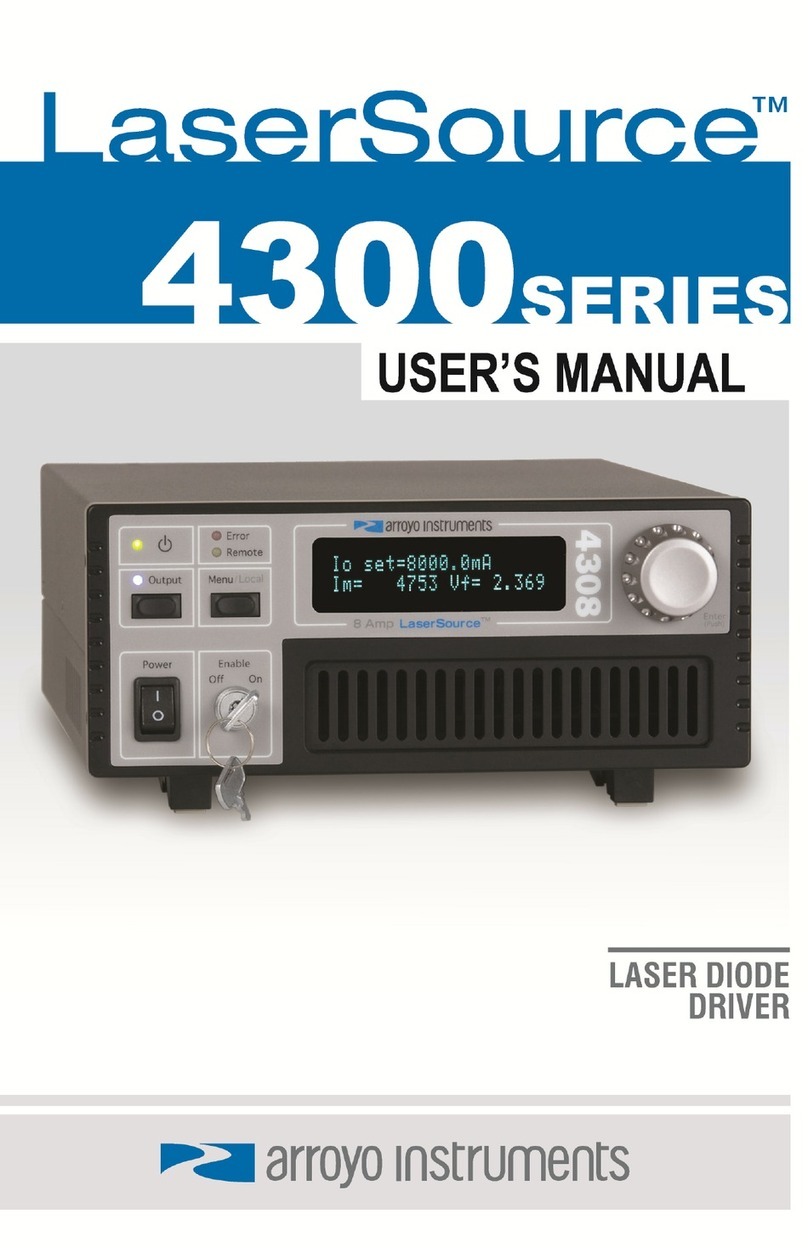
Arroyo Instruments
Arroyo Instruments LaserSource 4300 Series user manual
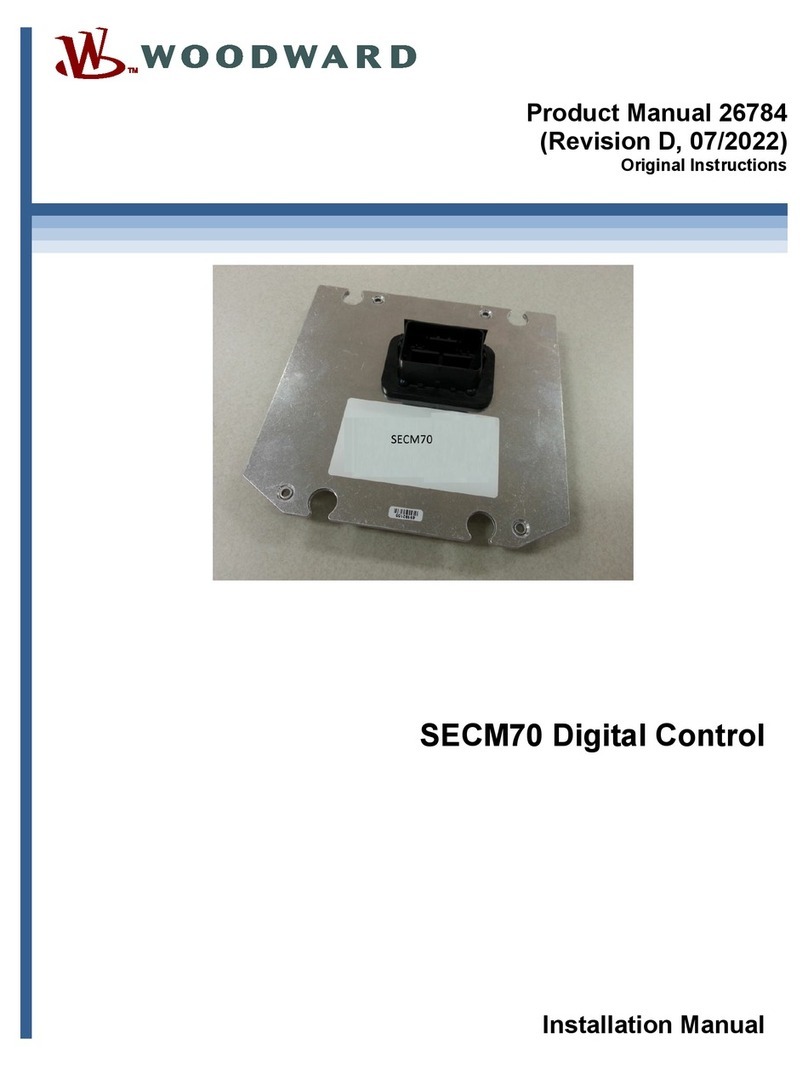
Woodward
Woodward SECM70 installation manual
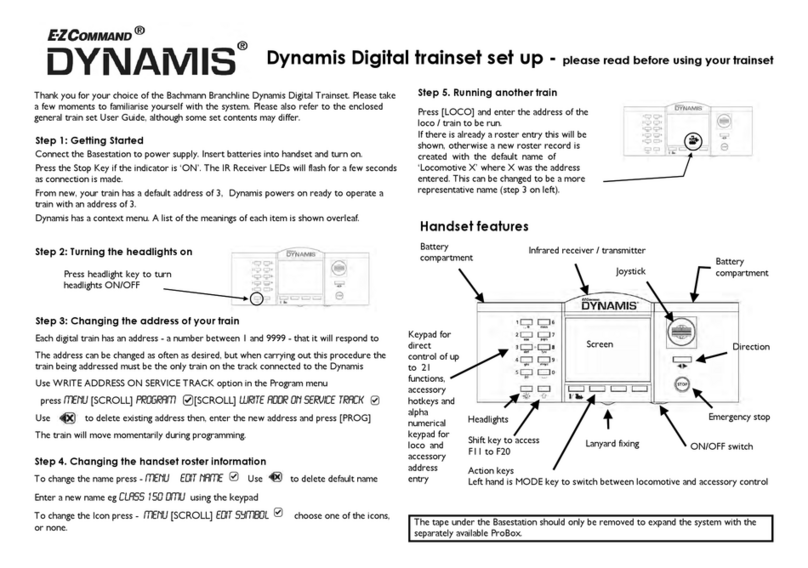
Bachmann
Bachmann E-Z Command Dynamis Setup
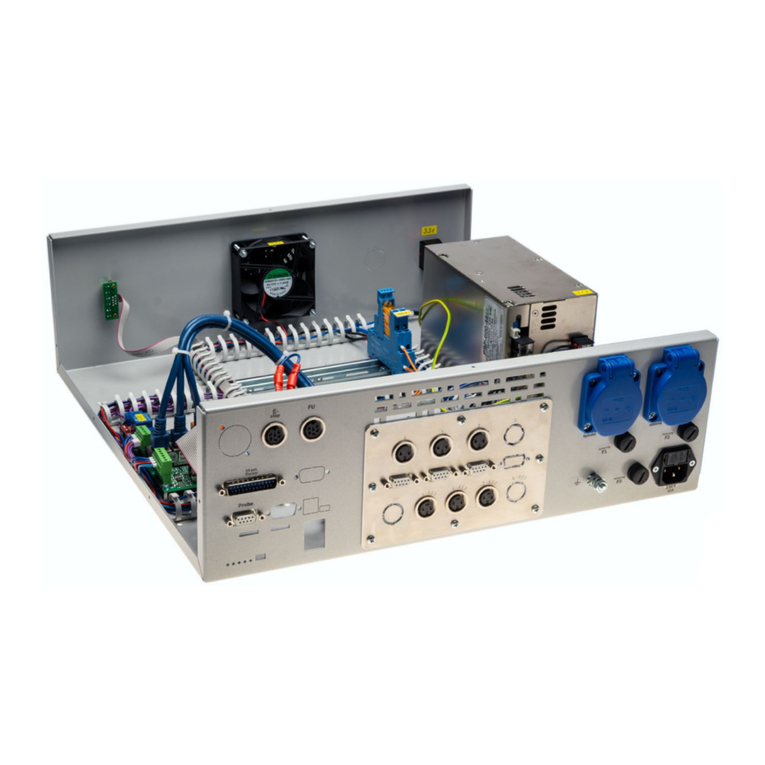
Sorotec
Sorotec PRO ITG 3 axes Benezan Assembly instructions

Johnson Controls
Johnson Controls VMA1200 Series Technical bulletin

Allen-Bradley
Allen-Bradley controllogix 1756-L61 user manual

